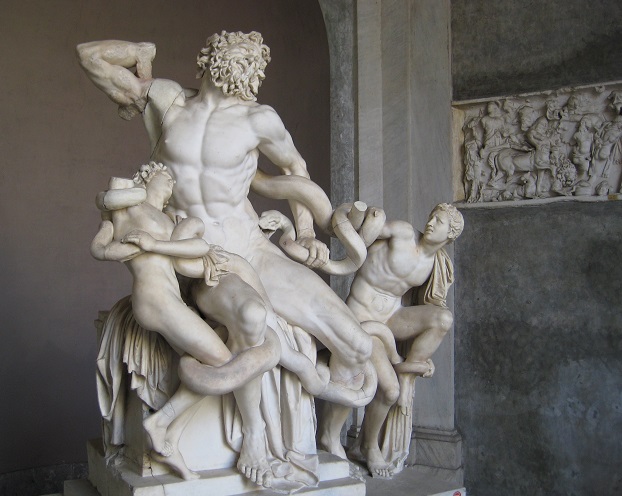
Your virtual Italy vacation continues with Thor and me as we hit highlights of the magnificent collections in the Vatican Museums.
NOTE: Since travel is still on hold with the pandemic continuing, I’ve started a new blog series offering a virtual vacation and time-travel to my first big trip with Thor in 2008. Italy! Starting with highlight photos posted here on Saturday, Jan. 30, I’ll continue every week. Join us in Rome, Florence, Cinque Terre, Venice, and Milan. Buon viaggio!
The Vatican Museums are housed in several interconnected structures that were built as papal palaces over several centuries. The popes had collected an amazing array of important secular and religious art, and the reorganization as a series of museums open for viewing finally happened in the 18th century. I had two “must-see” destinations here — the astounding 1st-century AD marble carving of the Laocoon (above, more later), and the mind-boggling artistry of the fresco paintings of the Sistine Chapel by Michelangelo. I regret that Thor and I didn’t have time to spend a full day here, which the collections deserve. And I really regret having somehow lost my photos of the trip, but Thor took enough to show the amazing variety. We’ll just have to return some day, since of course we did toss our coins into the Trevi Fountain.
Here we go:
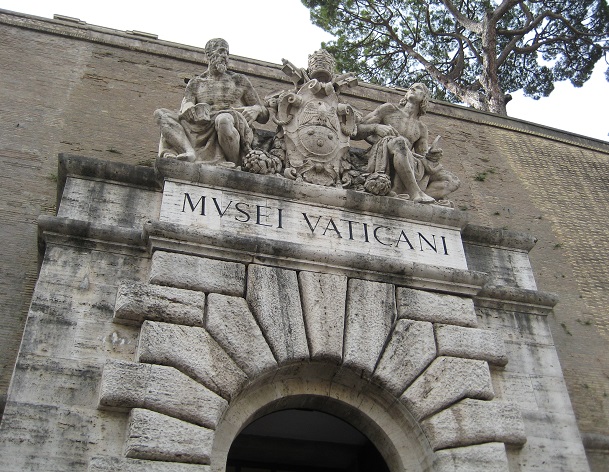
Patience with crowds and long lines required.
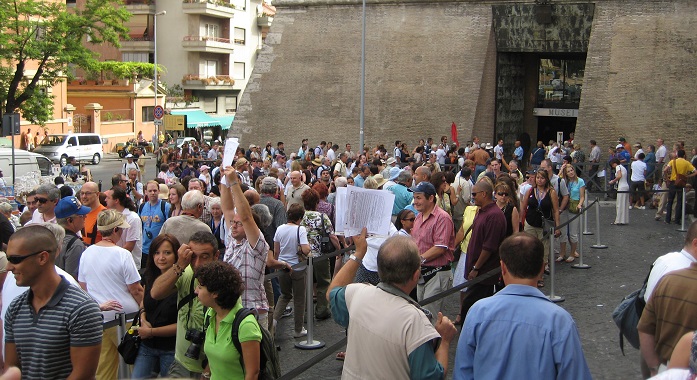
Two parallel “halls” run about a quarter-mile each from the entrance to the Sistine Chapel next to St. Peter’s Square and the basilica (see my blog post from March 27). These interconnected galleries, part of previous papal palaces, are sumptuously decorated and lined with sculptures, paintings, and tapestries. One reason for Luther’s Protestant Reformation was to protest the extravagant spending by the popes. The collections and embellishments, whatever your beliefs, remain a source of wonder and preserved history.
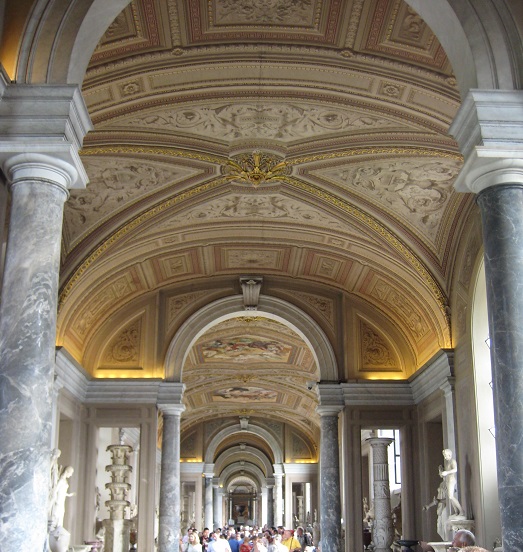
A glimpse of inlaid marble flooring:
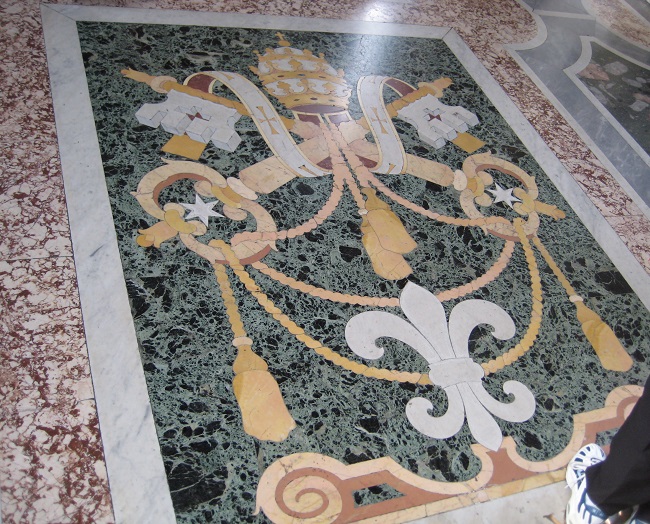
The Map Gallery was overwhelming, the ceiling and walls covered with baroque embellishment. Elaborate figures and framing surround these ceiling paintings:
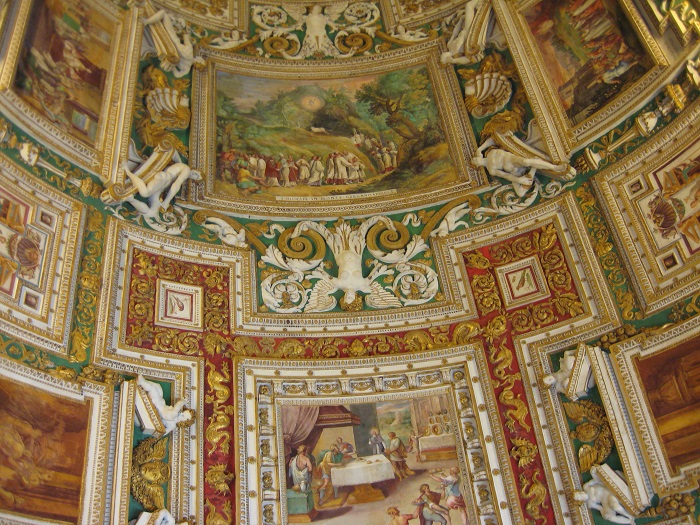
It was rather dizzying to walk down this long gallery, staring up at the exuberance of the ceiling while taking in the walls covered with maps of all the regions of Italy in the late 16th century. The ceiling scenes represent important events in Church history in the different regions.
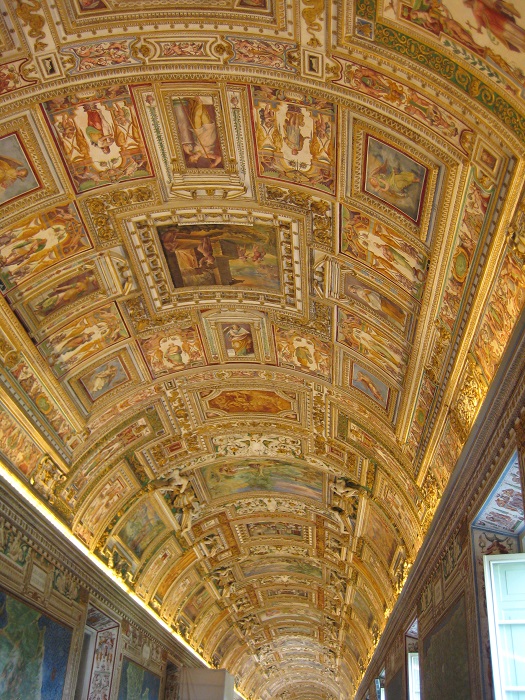
One of the wall maps, of Calabria, complete with sailing ships and sea monsters. These paintings were the official maps of Italy until the 19th century!
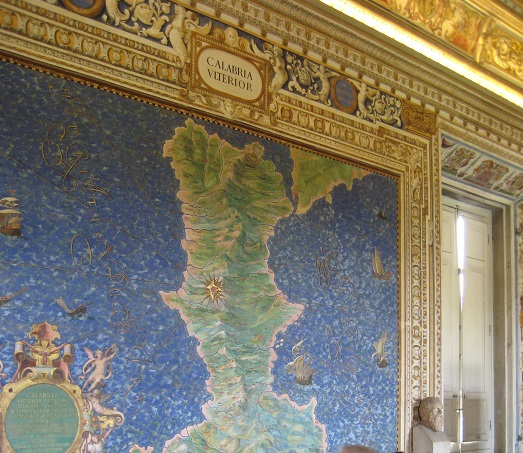
The Ancient Wing made me drool, with magnificent collections of Egyptian, Etruscan, Greek, and Roman art and artifacts. (I resisted the urge to pet the Egyptian jackal-headed god Anubis.) A psychopomp, the god escorted the dead to the afterlife and oversaw processes such as embalming. I noted that he held a winged-serpent caduceus staff, also identified with the Greek god Hermes and with the healing staff of Asklepios.
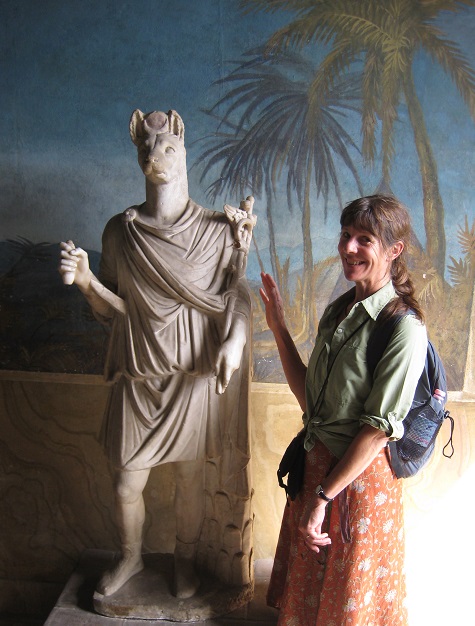
The Greek goddess Artemis is usually presented as the athletic virgin hunter and guardian of the wilderness, but this image presents her as a fertility figure. Scholars raise two possibilities: She either has multiple breasts, or she has been draped with the testicles of sacrificed bulls. Both symbolize fertility.
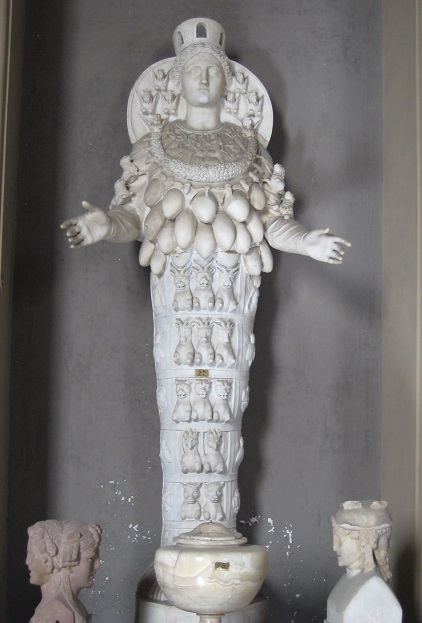
One quest achieved — seeing the Laocoon carving! I have long admired images of this amazing marble carving by three artists from Rhodes (recorded by the historian Pliny), probably created between 25 B.C. and 65 A.D. It’s a powerful presence at 6.7 feet high, and made an electrifying impression on a young Michelangelo after the statue was discovered buried near the Roman Coliseum in 1506.
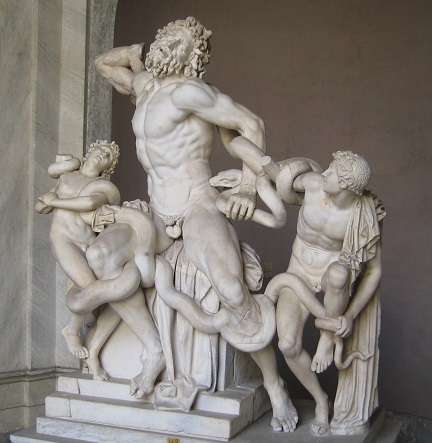
The grouping tells the story of the Trojan priest of Poseidon, Laocoon, who tried to warn the citizens about the Trojan horse left at the gates by the Greeks — a trick conceived by Odysseus, who hid with other soldiers inside the huge wooden horse. Those Greek gods were always tussling over which mortals they favored, and in this case one of them sent serpents to kill Laocoon and his sons. There are several versions of this story, so scholars can continue to wrangle.
Apparently Church eminences decided that nude ancient statues were obscene, so between 1500 and 1800 A.D., they added plaster fig leaves to many of them. Thankfully, Laocoon was spared this indignity.
Mounted on the wall behind Laocoon was this frieze featuring a centaur among other figures:
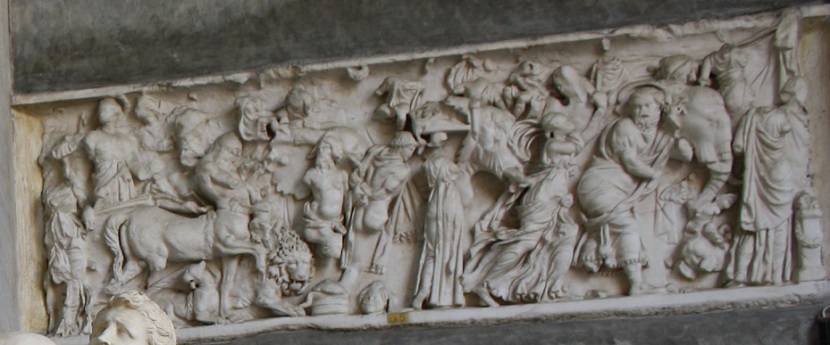
The mosaic room was paved with beautiful tiled images of mythical figures and animals:
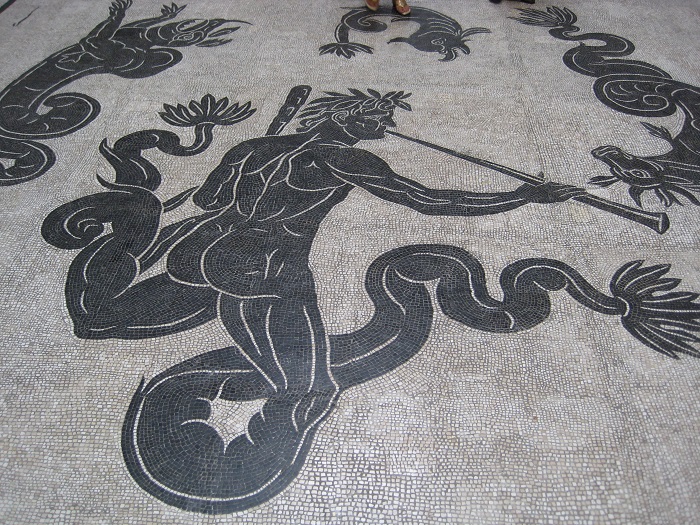
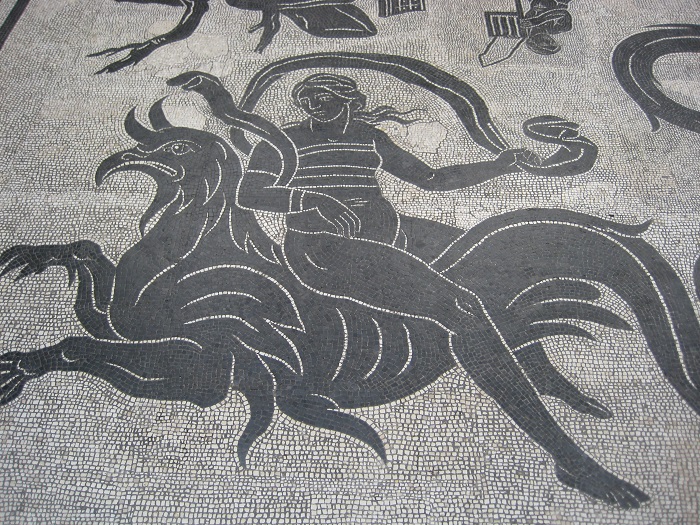
Finally we reached the hall leading to the Sistine Chapel, filled with people as eager as I was to see the famous Michelangelo paintings.
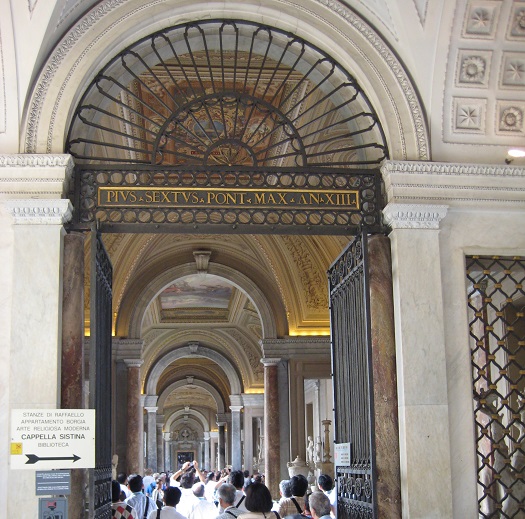
Visitors are allowed only a short time inside the chapel, due to the lineups, but it’s enough time to surrender to the majesty of Michelangelo’s artistry and dedication in painting the entire ceiling by himself, atop scaffolding he designed. It took him four years, from 1508 to 1512. Apparently Michelangelo at first refused the pope’s request to paint the ceiling, considering himself more a sculptor than a painter, but we can all be glad he relented and took the commission. Seeing in person the central image of God reaching his finger toward newly-created Adam’s hand filled me with awe at his achievement.
No photos are allowed in the chapel, but here’s a good link for an overview of the ceiling and all of the images covering Biblical events up to the birth of Jesus. It’s easy to see the influence of the muscular Greek statues on Michelangelo’s work, which was a departure from earlier, more ethereal depictions of Biblical figures.
Equally impressive is the later Michelangelo painting on the altar wall, The Last Judgement. He undertook this work 23 years after the ceiling fresco, among backlash against the Reformation, with religious wars raging. The mood of this painting is rather harsh in its presentation of an angry, punishing Christ presiding over the disposition of the good and the bad souls.
https://smarthistory.org/michelangelo-last-judgment/
This spiral ramp, built in 1930, leads back to the museum entrance, and back to modern Italy.
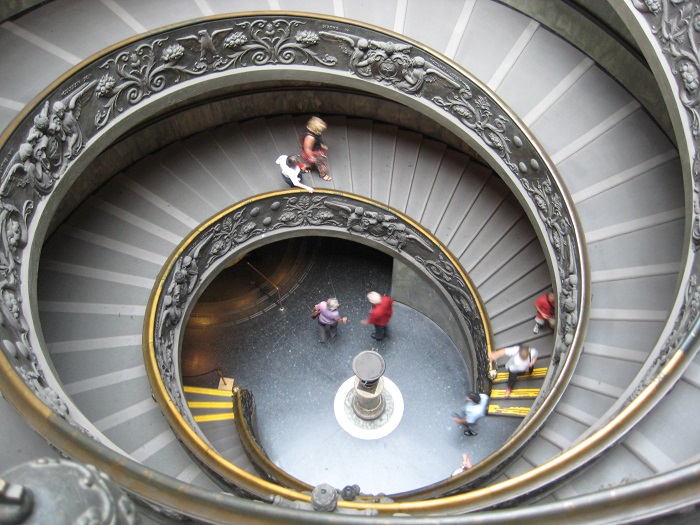
Next week: On to Florence, the city of artists old and new.
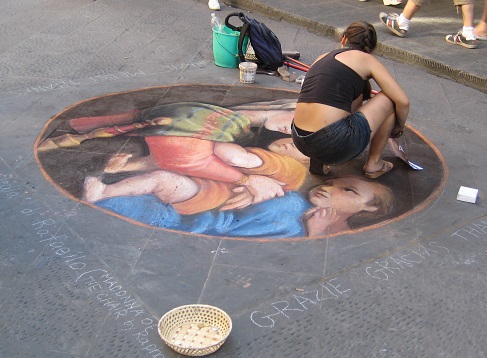
*****
You will find The Rambling Writer’s blog posts here every Saturday. Sara’s latest novel from Book View Cafe is available in print and ebook: The Ariadne Connection. It’s a near-future thriller set in the Greek islands. “Technology triggers a deadly new plague. Can a healer find the cure?” The novel has received the Chanticleer Global Thriller Grand Prize and the Cygnus Award for Speculative Fiction. Sara has recently returned from another research trip in Greece and is back at work on the sequel, The Ariadne Disconnect. Sign up for her quarterly email newsletter at www.sarastamey.com

1 thought on “The Rambling Writer’s Italy, part 10: The Vatican Museums”